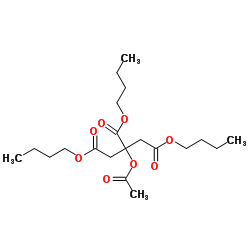Tributyl citrate acetate

Tributyl citrate acetate structure
|
Common Name | Tributyl citrate acetate | ||
|---|---|---|---|---|
| CAS Number | 77-90-7 | Molecular Weight | 402.479 | |
| Density | 1.1±0.1 g/cm3 | Boiling Point | 418.1±40.0 °C at 760 mmHg | |
| Molecular Formula | C20H34O8 | Melting Point | -59 °C | |
| MSDS | Chinese USA | Flash Point | 175.1±27.4 °C | |
|
Intestinal pregnane X receptor links xenobiotic exposure and hypercholesterolemia.
Mol. Endocrinol. 29 , 765-76, (2015) Recent studies have associated endocrine-disrupting chemical (EDC) exposure with the increased risk of cardiovascular disease in humans, but the underlying mechanisms responsible for these associations remain elusive. Many EDCs have been implicated in activat... |
|
|
Mechanistic analysis of PLGA/HPMC-based in-situ forming implants for periodontitis treatment.
Eur. J. Pharm. Biopharm. 94 , 273-83, (2015) In-situ forming implant formulations based on poly(lactic-co-glycolic acid) (PLGA), acetyltributyl citrate (ATBC), minocycline HCl, N-methyl pyrrolidone (NMP) and optionally hydroxypropyl methylcellulose (HPMC) were prepared and thoroughly characterized in vi... |
|
|
Effect of PMMA polymer on the dynamic viscoelasticity and plasticizer leachability of PEMA-based tissue conditioners.
Dent. Mater. J. 29(4) , 374-80, (2010) The purpose of this study was to determine the effect of PMMA polymer on dynamic viscoelasticity and plasticizer leachability of PEMA-based tissue conditioners. One PEMA polymer and one PMMA polymer were used in powder form with four formulations. The combina... |
|
|
Open flap debridement and guided tissue regeneration after 10 years in infrabony defects.
J. Clin. Periodontol. 36(11) , 976-83, (2009) Evaluation of the 10-year results after open flap debridement (OFD) and guided tissue regeneration (GTR) therapy of infrabony defects in a randomized controlled clinical trial.In 16 periodontitis patients OFD or polylactide acetyltributyl citrate barriers (GT... |
|
|
Effect of high-dose electron beam irradiation on the migration of DOA and ATBC plasticizers from food-grade PVC and PVDC/PVC films, respectively, into olive oil.
J. Food Prot. 61(6) , 720-4, (1998) The effect of high-dose irradiation on the migration of dioctyl adipate (DOA) and acetyl tributyl citrate (ATBC) plasticizers from food-grade poly (vinyl chloride) (PVC) and poly (vinylidene chloride/vinyl chloride) (PVDC/PVC) copolymer (Saran) films, respect... |
|
|
Regenerative periodontal surgery in interproximal intrabony defects with biodegradable barriers.
J. Clin. Periodontol. 27(3) , 162-8, (2000) The comparison of the effects of guided-tissue regeneration (GTR) using 2 different biodegradable barriers (polylactide acetyltributyl citrate; polydioxanon) in 3- and 2-wall intrabony defects.The polydioxanon barrier is an experimental membrane for GTR thera... |
|
|
Migration of acetyl-tributylcitrate from plastic film into poultry products during microwave cooking.
Poult. Sci. 60(10) , 2258-64, (1981) Migration of the plasticizer acetyl-tributylcitrate from a plastic film into poultry meat and model food systems was studied. It was determined that this commonly used plasticizer migrated from the plastic film during microwave cooking by comparing the infrar... |
|
|
Mutagenesis testing of acetyl-tributylcitrate and epoxidized soybean oil.
Poult. Sci. 61(12) , 2517-9, (1982) Mutagenesis testing was conducted on two plasticizers commonly used in plastic wrap manufacture, acetyl-tributylcitrate and epoxidized soybean oil. There is no record of mutagenic testing using a bacterial screening method for these two compounds. The two pla... |
|
|
Laser transmission through membranes using the Q-switched Nd:YAG laser.
Lasers Surg. Med. 24(1) , 48-54, (1999) Many laser centres utilise various transparent membranes during treatment sessions with Q-switched lasers to prevent or reduce tissue splatter, thereby reducing the aerosolised biohazard of cellular debris to operator and laser.We performed a series of experi... |
|
|
Acetyl tributyl citrate, the most widely used phthalate substitute plasticizer, induces cytochrome p450 3a through steroid and xenobiotic receptor.
Toxicol. Sci. 123(2) , 460-70, (2011) Steroid and xenobiotic receptor (SXR) is activated by endogenous and exogenous chemicals including steroids, bile acids, and prescription drugs. SXR is highly expressed in the liver and intestine, where it regulates cytochrome P450 3A4 (CYP3A4), which in turn... |